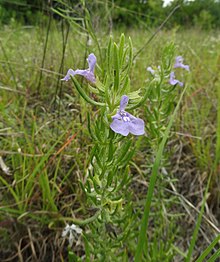Salvia texana
Appearance
| Salvia texana | |
|---|---|

| |
| Scientific classification | |
| Kingdom: | Plantae |
| Clade: | Tracheophytes |
| Clade: | Angiosperms |
| Clade: | Eudicots |
| Clade: | Asterids |
| Order: | Lamiales |
| Family: | Lamiaceae |
| Genus: | Salvia |
| Species: | S. texana
|
| Binomial name | |
| Salvia texana (Scheele) Torr.
| |
Salvia texana, commonly called Texas sage,[1] is a species of flowering plant in the mint family (Lamiaceae).[2] It is native to North America, where it is found in northern Mexico, and in the U.S. states of Texas and New Mexico. Its natural habitat is dry areas on limestone soils, in prairies or over rock outcrops.[2][3]
It is an herbaceous perennial that grows 1 to 1.5 ft (0.30 to 0.46 m) tall. It has with hairy lanceolate-oblanceolate leaves. The flowers are purple-blue. It resembles Salvia engelmannii in appearance, but has a longer bloom period, smaller and darker flowers, and unopened green buds at the top of the plant.[2][3]
References
[edit]- ^ NRCS. "Salvia texana". PLANTS Database. United States Department of Agriculture (USDA). Retrieved 10 February 2018.
- ^ a b c "Salvia texana". Native Plant Database. University of Texas at Austin. 2009-11-17. Retrieved 28 June 2010.
- ^ a b Diggs, George; Lipscomb, Barney; O'Kennon, Robert (1999). Flora of North Central Texas. Botanical Research Institute of Texas. p. 776.
